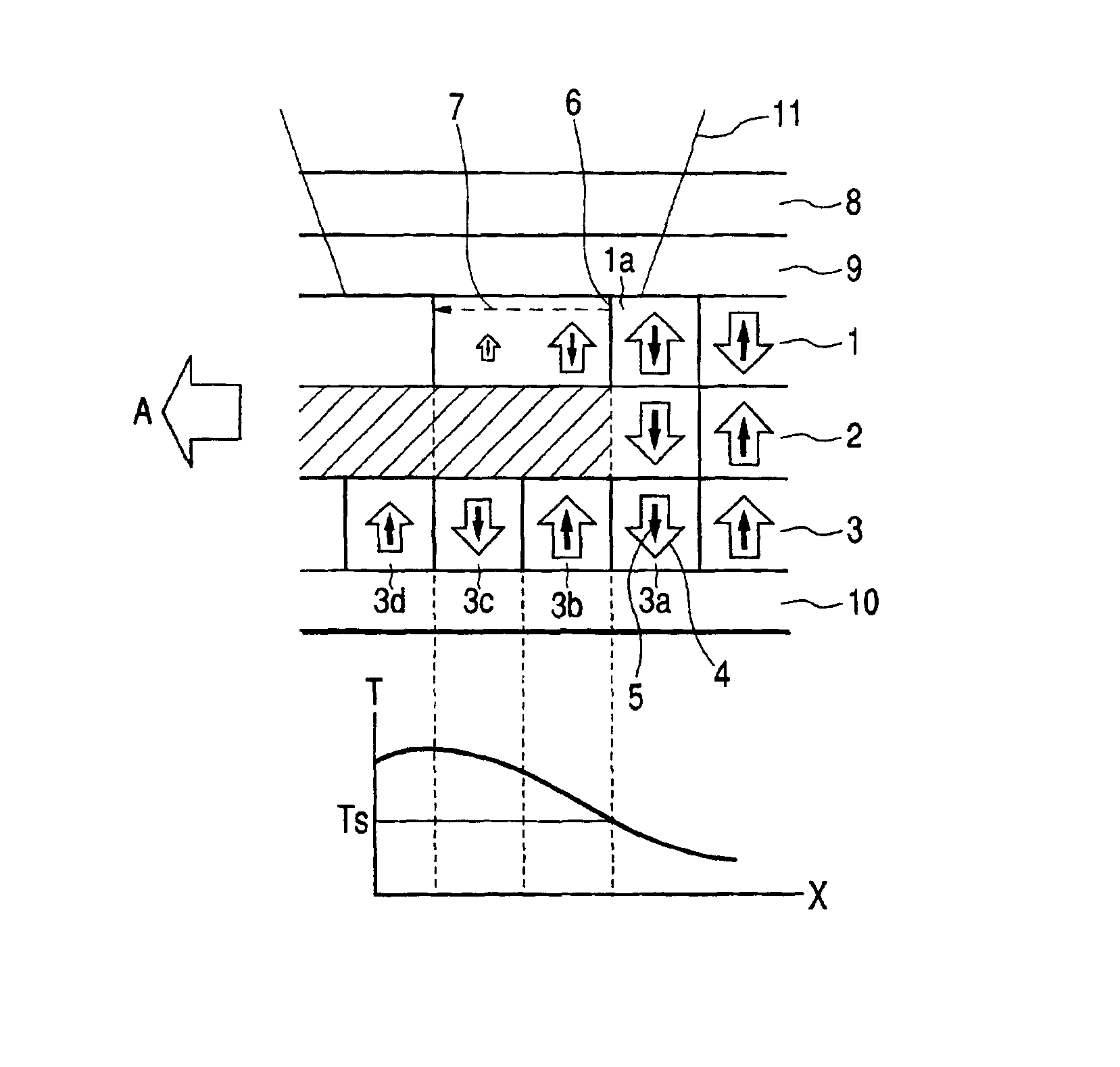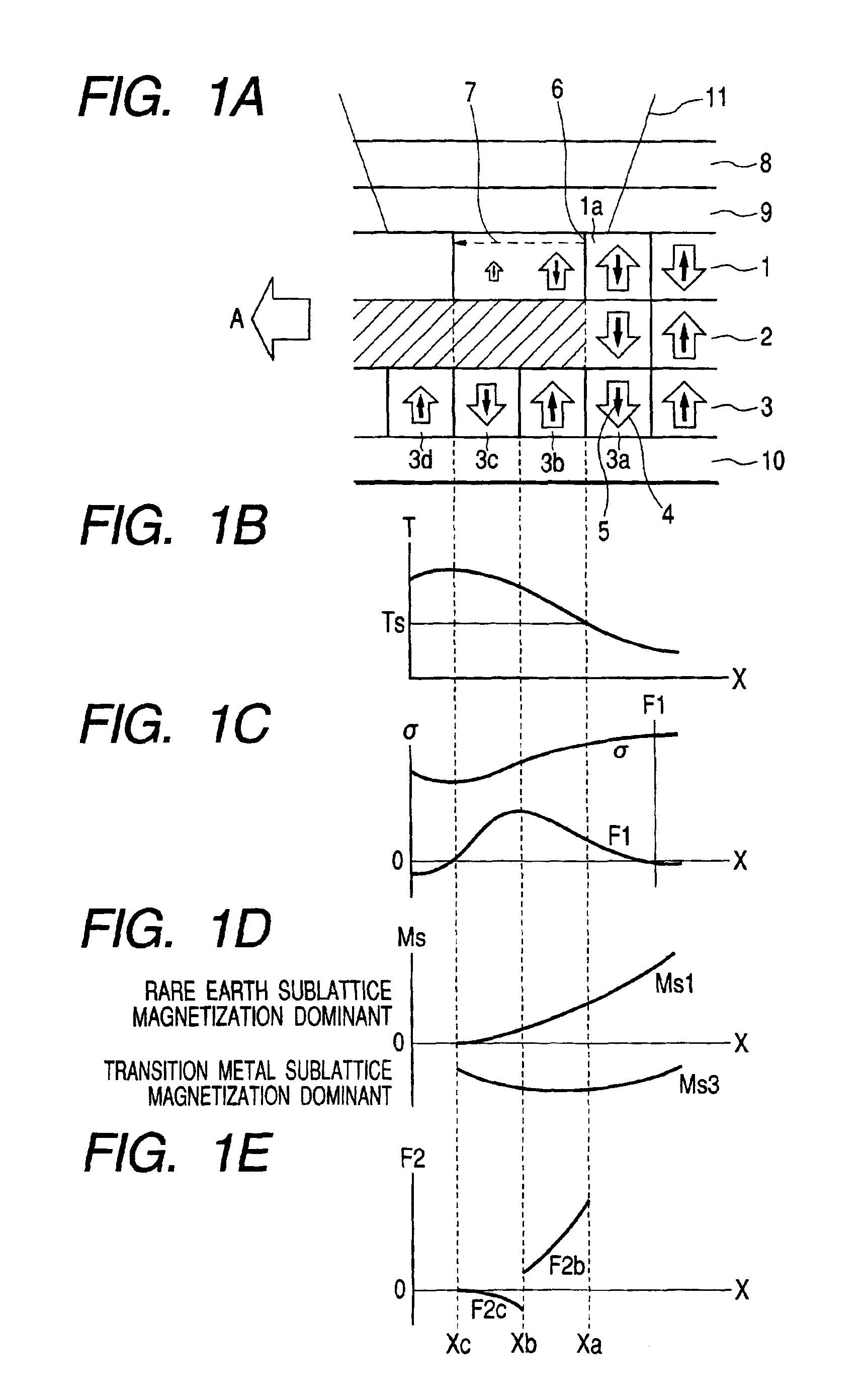Domain wall-displacement type magneto-optical medium and reproducing method for the same
- Summary
- Abstract
- Description
- Claims
- Application Information
AI Technical Summary
Benefits of technology
Problems solved by technology
Method used
Image
Examples
example 1
[0075]FIG. 4 is schematic cross sectional view of the magneto-optical recording medium of Example 1, illustrating the basic multilayer structure thereof. Like the magneto-optical recording medium described above by referring to FIG. 1A, this magneto-optical recording medium comprises a bottom layer 9, a magnetic layer 1 that is a domain wall displacement layer, another magnetic layer 2 that is a switching layer, still another magnetic layer 3 that is a recording layer and a surface layer 10 laid sequentially on a substrate 8.
[0076]The substrate 8 is typically made of polycarbonate or glass. In this example, a land / groove recording type glass 2P substrate having a track pitch of 0.6 μm and a groove depth of about 180 nm was used for the substrate 8. The bottom layer 9 is typically made of a transparent dielectric material such as Si3N4, AlN, SiO2, SiO, ZnS or MgF2. A similar dielectric material may be used for the surface layer 10 that is formed as protection layer. These layers can ...
example 2
[0084]FIGS. 6A through 6C schematically illustrate the principle of reproducing signals from the magneto-optical recording medium of Example 2. FIG. 6A is a schematic cross sectional view of the magneto-optical recording medium of Example 2, illustrating its configuration and the change in the magnetized state thereof when irradiated with a reproducing light beam and FIG. 6B is a graph illustrating the distribution of the saturation magnetization of the domain wall displacement layer and that of the saturation magnetization of the recording layer corresponding to the temperature distribution produced in the recording medium when irradiated with a reproducing light beam, whereas FIG. 6C is a graph illustrating the distribution of the magnetostatic force generated by the distribution of saturation magnetization of FIG. 6B. In FIG. 6A, the elements that are the same as or similar to those of FIG. 1A are denoted respectively by the same reference symbols.
[0085]The magneto-optical record...
example 3
[0092]The magneto-optical recording medium of this example is identical with that of Example 1 except that the composition of the domain wall displacement layer, that of the switching layer and that of the recording layer were different from those of the specimen of Example 1. More specifically, a composition of Tb0.19Fe0.73Al0.08 was used for the switching layer so as to make its Curie temperature Ts equal to about 130° C. and a composition of Gd0.22Fe0.61Co0.10Al0.07 was used for the domain wall displacement layer to make its Curie temperature Ts equal to about 260° C. and transition metal sublattice magnetization become dominant at and near the Curie temperature Ts (130° C.) of the switching layer, whereas Tb0.25Fe0.52Co0.23 was used for the recording layer to make its Curie temperature Ts equal to about 320° C. and rare earth sublattice magnetization become dominant at and near the Curie temperature Ts (130° C.) of the switching layer.
[0093]The magneto-optical medium of this exa...
PUM
| Property | Measurement | Unit |
|---|---|---|
| Temperature | aaaaa | aaaaa |
| Magnetization | aaaaa | aaaaa |
Abstract
Description
Claims
Application Information
 Login to View More
Login to View More - R&D
- Intellectual Property
- Life Sciences
- Materials
- Tech Scout
- Unparalleled Data Quality
- Higher Quality Content
- 60% Fewer Hallucinations
Browse by: Latest US Patents, China's latest patents, Technical Efficacy Thesaurus, Application Domain, Technology Topic, Popular Technical Reports.
© 2025 PatSnap. All rights reserved.Legal|Privacy policy|Modern Slavery Act Transparency Statement|Sitemap|About US| Contact US: help@patsnap.com



